5 keys to investing in 2019
What a difference a year makes. 2018 began with synchronized global growth and a tax cut boost for the U.S. stockmarket, but it finished with an increasing focus on geopolitical tensions and plunging asset prices.
What can investors expect in 2019? New challenges and compelling investment opportunities are sure to arise. Here are five key investment themes to help navigate the markets this year.
1. Volatility is back. Prepare for more of it
An extended period of historic calm in equity markets came to a screeching halt in 2018 as volatility resurfaced in most markets. For example, after recording daily declines of 1% or greater only four times in 2017, the Standard & Poor’s 500 Composite Index fell by more than 1% on 32 separate days and more than 3% on five days. Overall, global stocks declined for the first time since 2015, as the MSCI ACWI slid 9.4% in U.S. dollar terms.
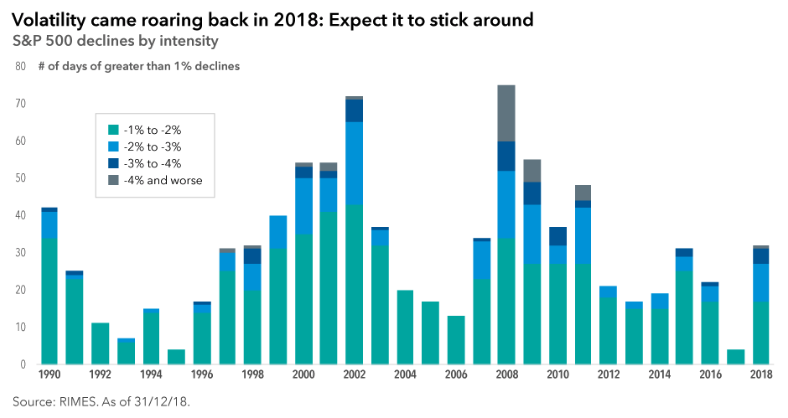
Investors can expect volatility to continue throughout 2019 as the primary trends driving the turbulence last year are likely to persist. Among these are the ongoing trade dispute, rising U.S. interest rates and mounting debt levels.
With regard to global trade, in early January leaders from the U.S. and China initiated discussions to resolve their ongoing dispute. However, investors are mindful that the disagreement could drag on as tariffs continue to disrupt the flow of goods among the U.S., China, Europe and other trade partners.
After raising interest rates four times in 2018, contributing to some of the market turbulence, the U.S. Federal Reserve has recently indicated that it may pause or slow rate hikes in 2019. While this may be heartening to uneasy investors, the Fed continues to sell assets to reduce its balance sheet, contributing to tighter monetary conditions. The tighter conditions, along with uncertainty over how the Fed plans to proceed could fuel volatility going forward.
Meanwhile, thanks to the historically low rates of recent years, debt levels have escalated as government agencies, consumers and companies have aggressively taken advantage of cheap debt. As debt-service costs rise, borrowers may have to limit their spending.
Although volatility can be jarring, it is part of how markets function. During times of market extremes, investors who can contain their emotions will be well served. Rather than taking rash action, make sure that portfolios are well diversified to weather market ups and downs.
2. Staying invested can be a key to success
Signs pointing to a lengthy bear market or an economic slowdown tend to put investors on edge. That is understandable. Steep market declines feel horrible and can induce investors to abandon stocks to avoid further pain. And recessions do inflict real damage, including job losses as companies pull back.
But history shows that taking a long-term view and sticking with it through recessions and bear markets can be rewarding. Indeed, a long-term focus can put economic slowdowns and down markets in perspective.
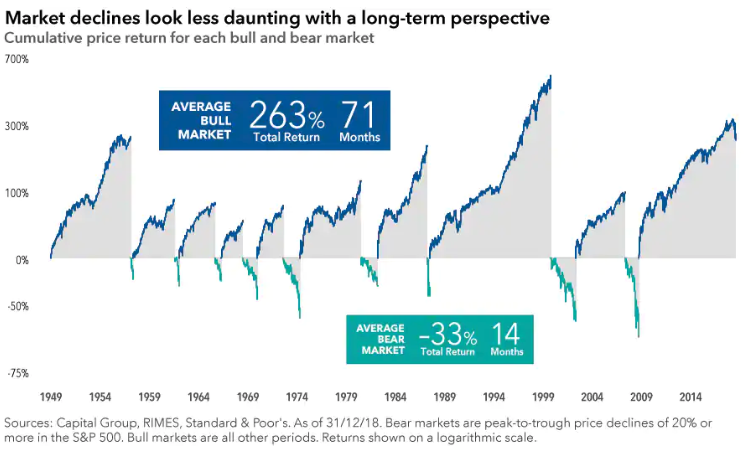
Periods of turmoil and steep market declines have subsequently proven to be among the best times to invest. Since 1949 there have been nine periods of 20%-or-greater declines in the S&P 500. The average decline of these cycles was 33%.
This can be painful to endure, but missing out on even part of the average bull market’s 263% gain could have an even more adverse impact on investors. What’s more, bear markets have averaged 14 months, a relatively short span compared with the average bull market. This further suggests that trying to time investment decisions can be difficult and potentially damaging.
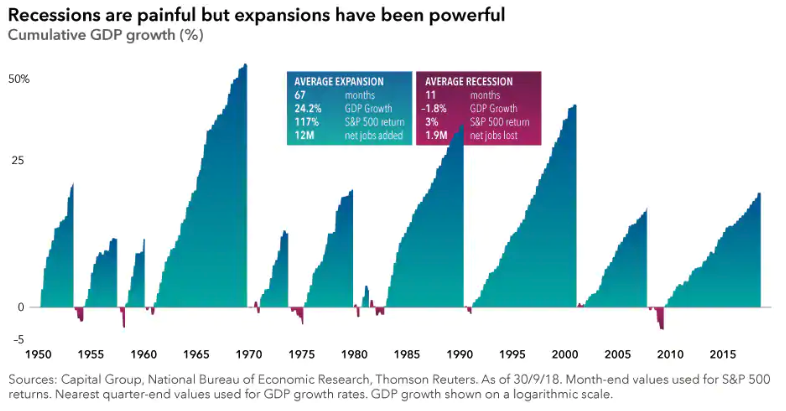
How much damage do recessions inflict relative to more prosperous expansionary periods? It helps to look at the big picture. Since 1950, the U.S. has been in recession 13.5% of the time. Many of those months included positive equity returns. And some of the strongest rallies occurred as stocks bounced back from those recessionary periods.
The lesson? Trying to time the market to avoid the impact of an economic slowdown can cause investors to miss some substantial rallies, potentially limiting overall returns.
3. Stay balanced with a diversified equity portfolio
Investors haven't really been rewarded for diversification over the past few years. For example, U.S. stocks have consistently outpaced non-U.S. markets and even within the U.S., market leadership has been concentrated among a handful of fast-growing technology and consumer companies, while value-oriented stocks have lagged the overall market.
But the recent market turbulence serves as a reminder that nothing can continue indefinitely. The general principle of diversification remains sound: Market leadership has tended to shift among asset classes from year to year. While history is not predictive of future returns, maintaining a broadly diversified portfolio that includes a mix of stocks and bonds from around the world can help mitigate volatility and provide access to opportunity across an evolving opportunity set.
Within the U.S., a closer look at eight major declines shows that broad market index results don’t tell the whole story. Through each of the declines, some sectors held up better than others. Many of the areas that have held up have paid meaningful dividends, which can offer steady return potential when stock prices are declining. Of course, not all dividend payers are equal. The key is to identify companies with strong balance sheets, good cash flows and the discipline to maintain dividend payments during declines.
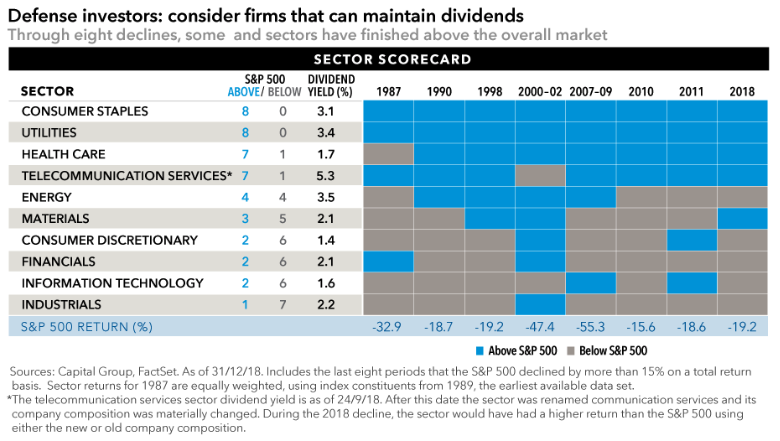
International and emerging stock markets have lagged the U.S. by a considerable margin for nearly a decade. This trend may well continue in 2019, when a busy calendar of political events in Europe — a Brexit resolution, European Parliament elections and the selection of a new president for the European Central Bank — is likely to further pressure equity prices.
However it is striking that in many sectors, there are comparable non-U.S. companies trading at lower valuations than their American domiciled counterparts. Classic examples include Airbus versus Boeing and Adidas versus Nike, but there are many more. Samsung trades at six times forward earnings, a level virtually unheard of among U.S. tech giants. Many of these companies have strong balance sheets, solid businesses and long runways. Over the long term, company fundamentals drive stock returns, not a company’s address or political turmoil.
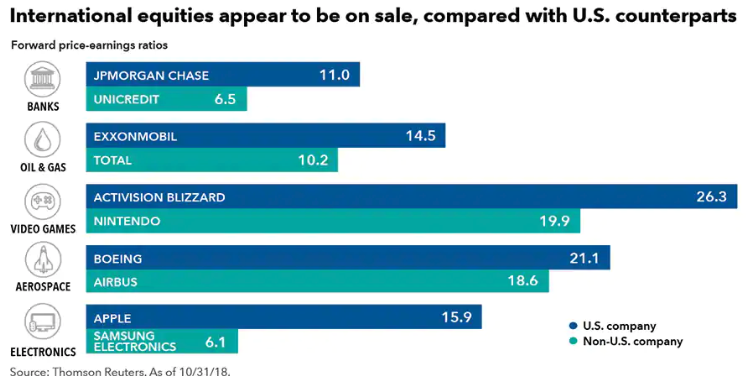
4. It may be time to upgrade your bond portfolios
Getting core fixed income allocations right is always important. But with the many economies entering late-cycle territory in 2019 and equity market volatility elevated, it’s critical for investors to ensure that core bond holdings provide balance to their portfolio. In other words, seek core fixed income offerings that offer elements of the four roles that bonds play: diversification from equities, income, capital preservation and inflation protection.
In the current environment it's important to ensure that core bond exposure is providing the desired 'anchor' to portfolio. Some core bond strategies have begun to prioritise boosting income over diversification and preservation. “Reaching for yield” can lead to lowering credit quality and thus some core holdings might not offer the diversification from equities that investors expect. When stock markets have been unsettled, high-quality bonds have shown resilience.
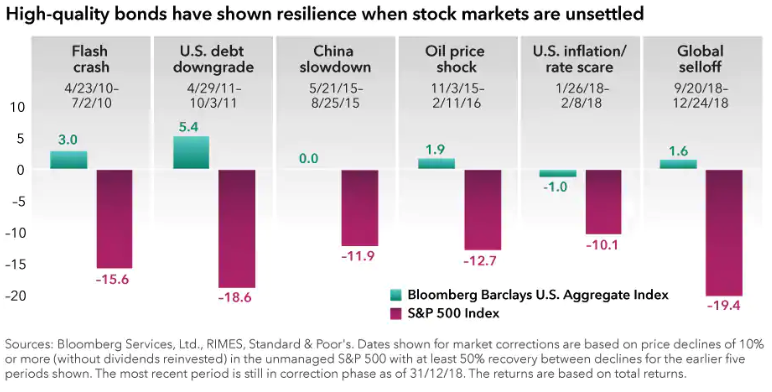
5. Keep a long-term view
Macroeconomic and political developments can cause turbulence in the short term, but company fundamentals drive markets in the long term. Rather than focusing on daily market volatility, investors seeking growth should look for companies with long runways and large addressable markets.
Technological advancements and shifting demographics are transforming global industries, creating massive new markets for innovative and nimble companies. Consider, for example, cloud computing, which has grown rapidly, slashing infrastructure costs for companies and transforming business models. The movement of IT workloads to the cloud is boosting demand for the services of Amazon Web Services and Microsoft’s Azure, the two leaders in cloud computing services.
In the field of biotechnology, rapid advances are bringing us ever closer to a cure for cancer. Companies like Abbvie, the maker of rheumatoid arthritis drug HUMIRA®, and Gilead Sciences, developer of treatments for HIV and hepatitis C, have invested heavily in the development of potential cancer therapies. With respect to global air travel, in 2017 more than 100 million people in Asia boarded a plane for the first time, reflecting rising affluence in the region. Worldwide, air passenger traffic is expected to reach 7.8 billion by 2036, sending demand soaring for new aircraft.
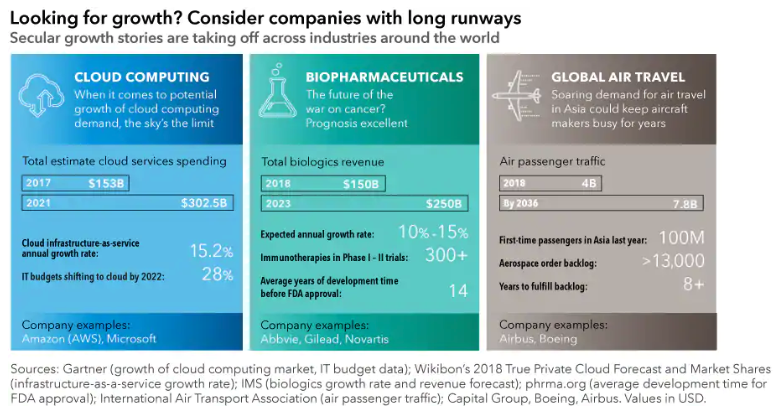
Did you enjoy that?
Gain insight into our history, philosophy, people, and unique approach to investment management - The Capital System - by exploring Capital Group in more detail.
1 contributor mentioned

